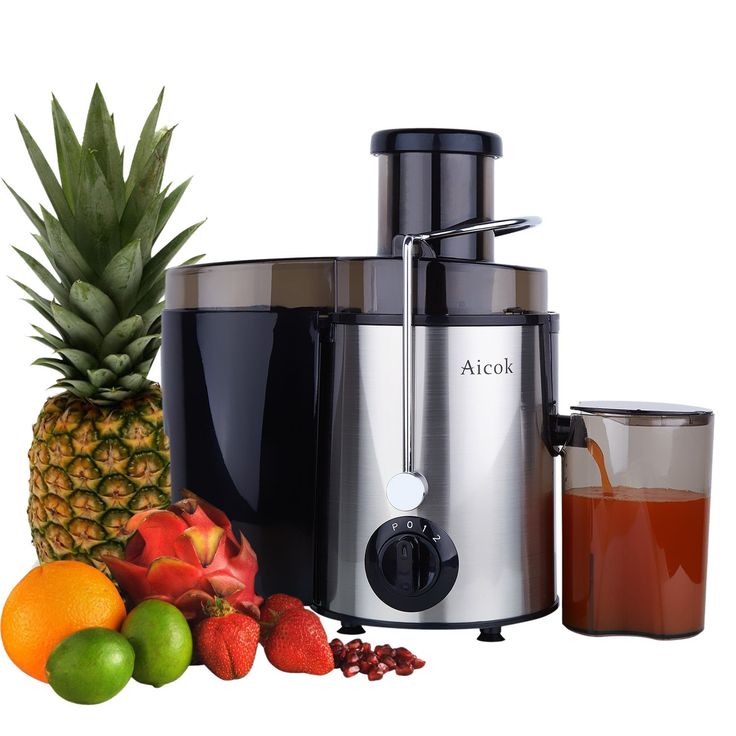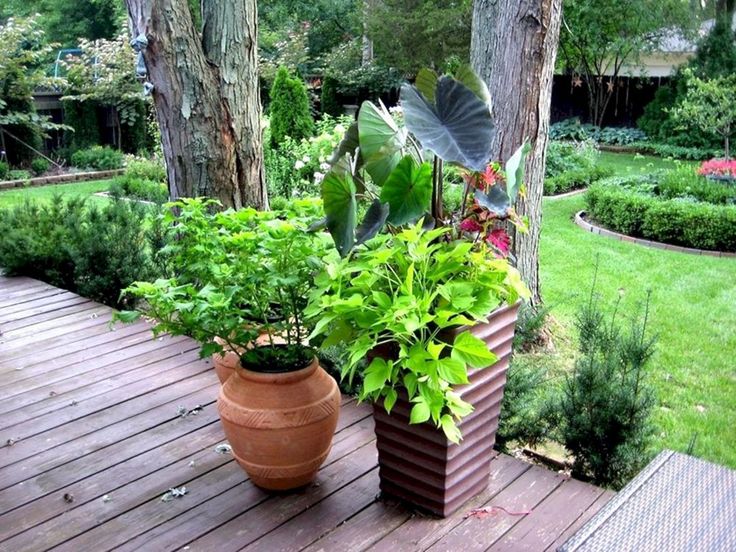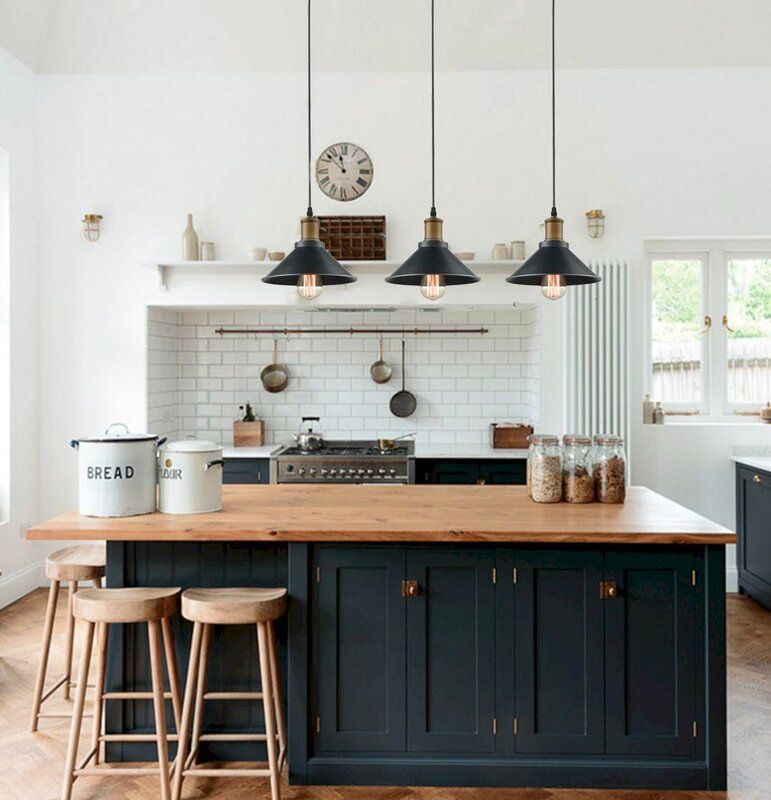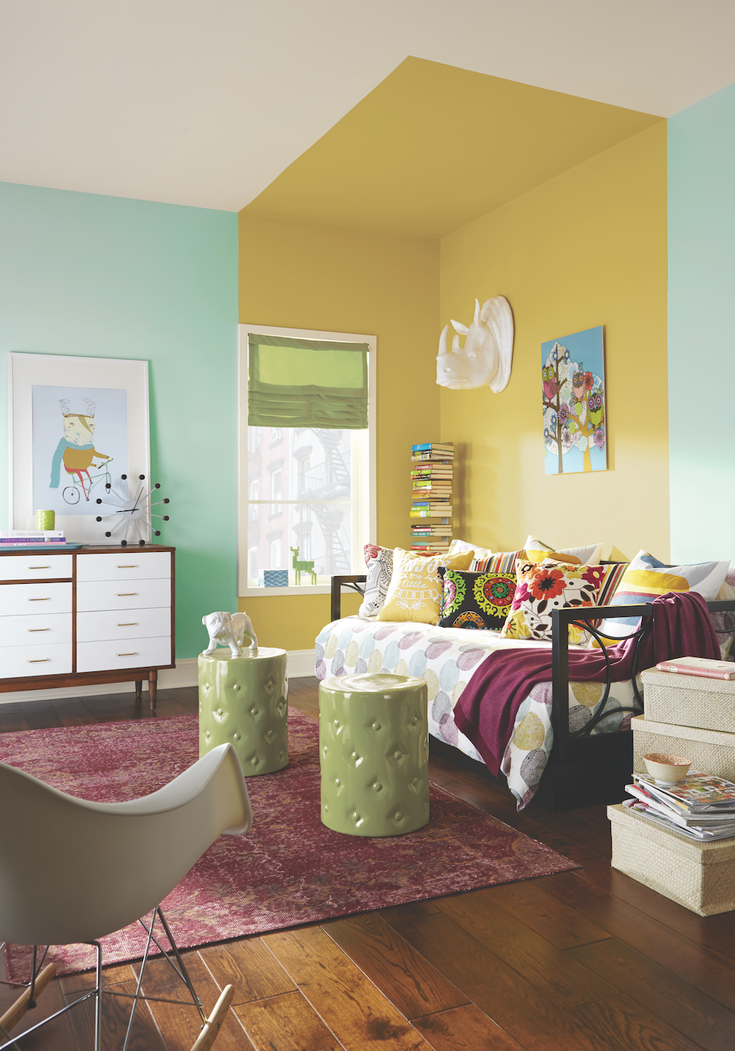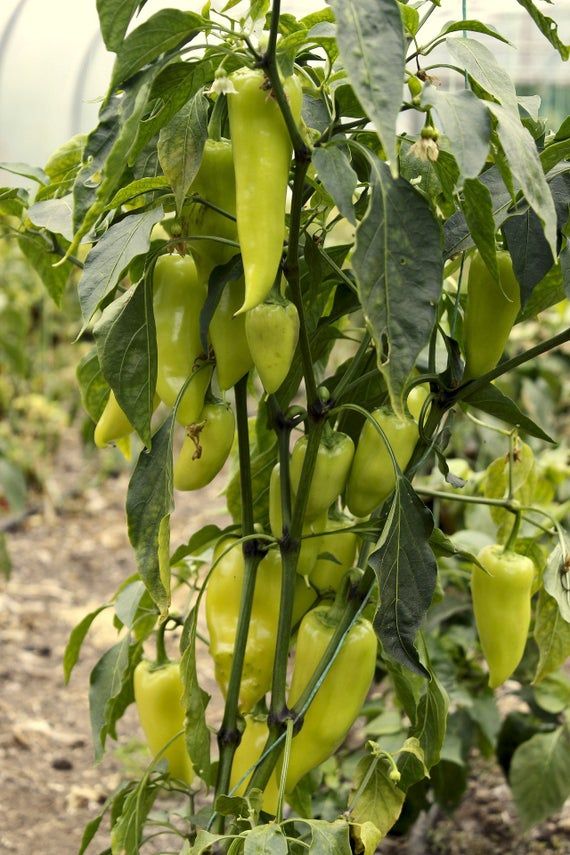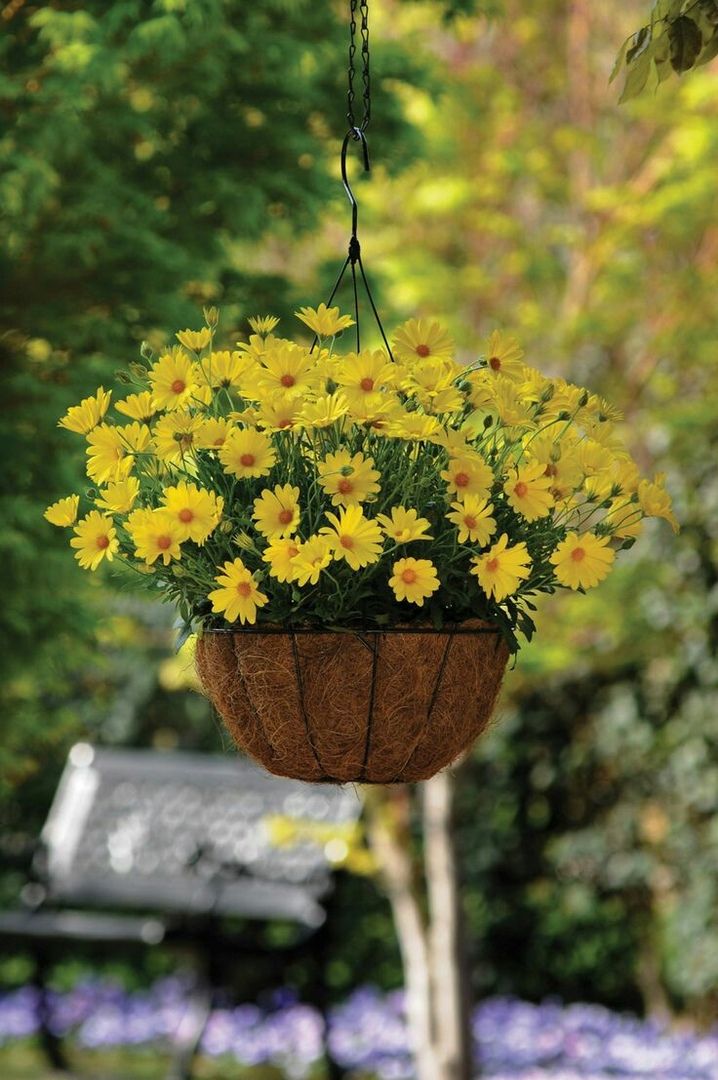Winter outdoor plants for containers
17 Perfect Outdoor Winter Plants for Pots
Winter is coming, but the winter months don’t have to mean your home has to be dreary and void of life.
A cold climate is often seen as ‘down time’ in the garden or houseplant world, but there are many winter plants for pots that thrive outside and provide great options to upgrade your home this winter.
Warm up your patio, front porch or deck with plants, using texture and color.
From evergreen foliage to vibrant flowers to vivid berries, the right outdoor winter plants for pots are a great way to create a lovely winter oasis that doesn’t require you to wait until early spring.
The Perfect Winter Plants for Pots
1. Camellia
Camellias are a popular plant in big spaces, but they also make good container plants.
Blooming in a variety of forms and colors even in the colder months, these are a great choice to add something to your home and once they outgrow their containers.
They can be transplanted to yards and gardens.
2. Boxwood Hedge
Boxwoods are easy-to-grow winter evergreen plants that can be used as hedges, edging plantings, or potted in plants.
They are tough plants that can withstand difficult climates and cold temperatures.
If possible, rotate the pot periodically to balance the plant’s sun exposure and therefore encourage even growth.
3. Viola Odorata (Sweet Violet)
Violas in general produce a variety of beautiful colors but the viola odorata are the blue violas you’ll often find in people’s yards.
They’re also known as wood violet or common violet. They bloom through cold weather and given proper care, they can also bloom in the summer months.
Not only are violas great plants to give your home a pop of color, but they are also edible so if you love using edible flowers, this is a great place to start.
Violas don’t require excessive care and are fairly low maintenance.
They need regular watering and a spot in partial shade.
Make sure to regularly deadhead (removing the dead leaves and flowers) them too as this will prolong the flowering period.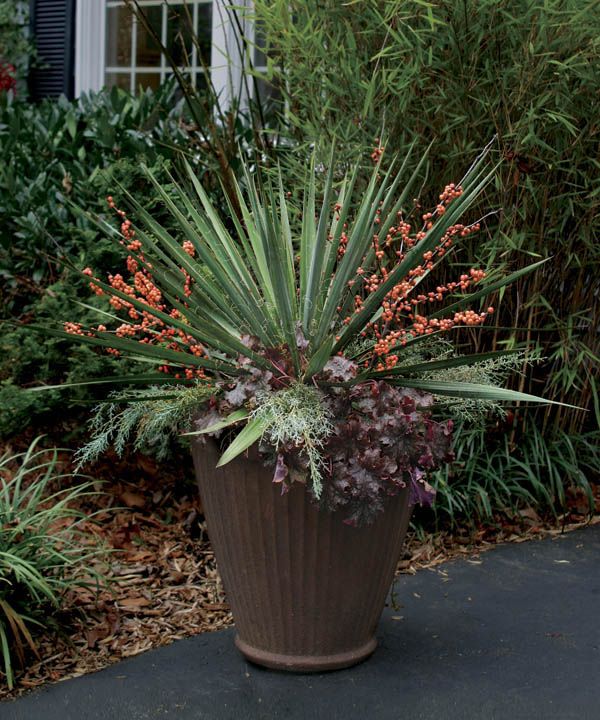
4. Pansies
Pansies are durable little plants and have the capability to survive freezing temperatures while also thriving in the summer.
Underwatering is one of the most common problems with pansies so don’t be shy about giving them needed water; just make sure they have good drainage.
5. Juniper
Evergreen juniper boasts needle-shaped foliage and is tolerant to drought.
They can grow as shrubs or in containers as column-shaped accents and therefore are good choices for a large container.
Their blue, waxy berries and green/blue-grey foliage are striking.
6. Erica carnea (Springwood Pink)
This plant is part of the winter-flowering heather family. It is an evergreen that loves to soak up the sun.
It is one of the best plants for the winter, requires low maintenance, and produces lovely pink and purple flowers in the winter months.
This plant will need some sun to produce vibrant colored flowers, but otherwise it can handle some minor neglect and the extreme cold.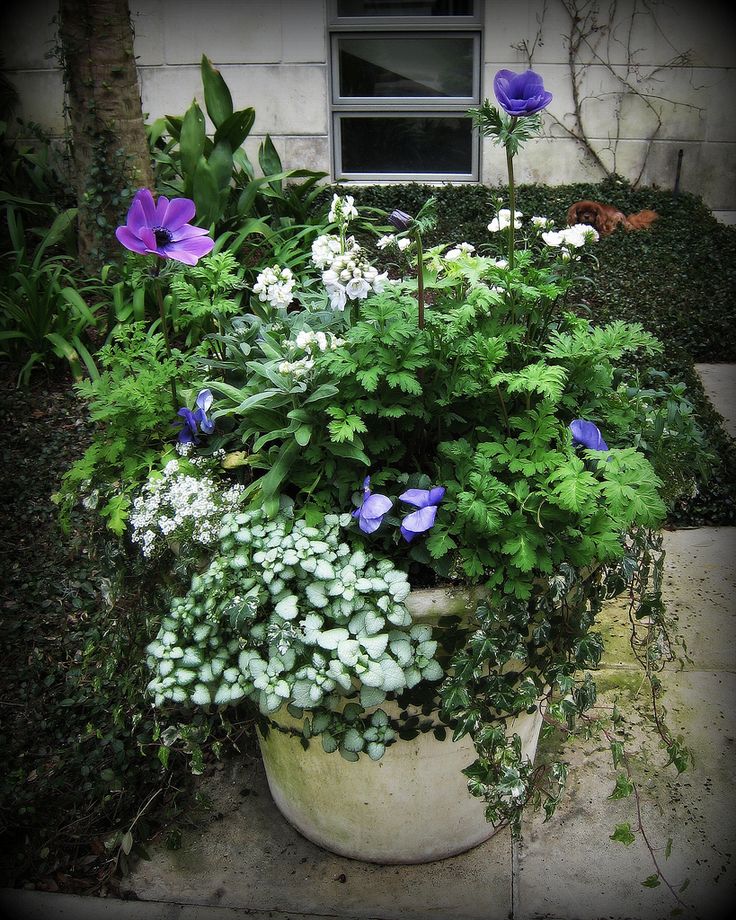
Let the soil dry before the next watering.
7. Gaultheria procumbens (Wintergreen)
This is a plant you’ve likely seen before as it has noticeable red berries. These outdoor plants love acidic, moist but well-drained soil.
They do not require a lot of water and can grow in both full and partial shade.
Wintergreen is one of the best picks when it comes to hardy winter plants for pots.
8. Clivia
Clivia has thick, dark-green long leaves and in the winter temperatures, a cluster of 15-20 flowers.
n the winter months, Clivia needs minimal water and it loves the shade.
9. Japanese Yew
This plant is great for a front porch year-round due to it’s tolerance to drought. It can also thrive in both full and partial sun.
It is most commonly used as groundcover or in winter containers.
However, it can also be grown as a tree and can reach more than 50 feet in height.
10. Cyclamen
These stunning plants are neat, free-flowering plants which grow really well at the base of trees and shrubs as a bedding plant.
Hardy cyclamen also grows really well in winter pots and can then be planted in the garden after flowering.
11. Ligustrum
This plant thrives in full sun and partial shade and is quite a popular choice as ornamental potted plants, especially in the Southwestern US states.
12. Creeping Jenny
Creeping Jenny is an ivy-like plant that does well as groundcover, but it can also grow in a pot especially while producing a vine-like effect in a hanging pot or a tall pot.
They do well in sun or partial shade. Make sure the containers have good drainage but water regularly, keeping the soil moist.
Creeping Jenny does well as a houseplant too, but will enjoy a cooler spot in the winter.
13. Helleborus niger (Christmas Rose)
This evergreen plant boasts a flower that looks much like a buttercup and is known affectionately as a Christmas Rose.
As the weather worsens, the wild white rose feeds off of it and produces large, round, white flowers with lots of deep green foliage.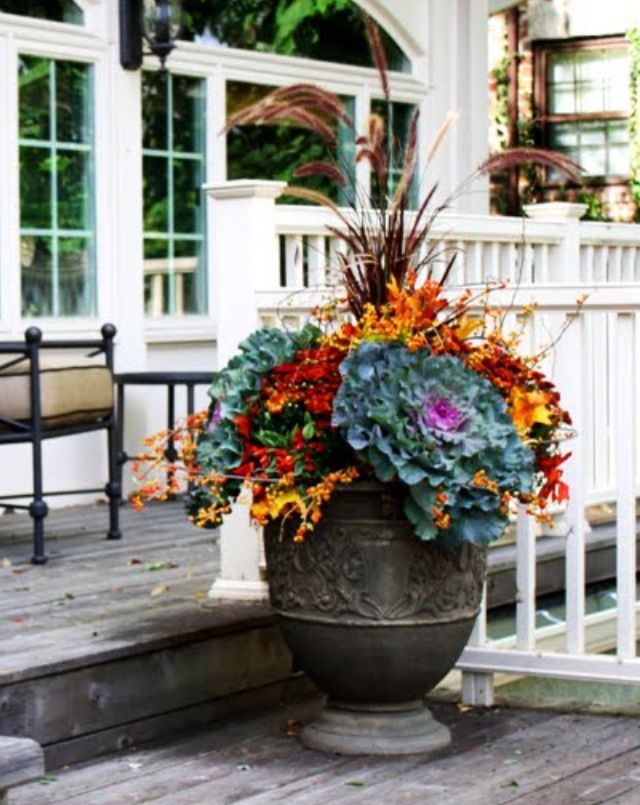
14. Blue Spruce
The blue spruce tree is a visually perfect winter plant. It is hardy in zones 2-7, prefers full sun, and is suitable for a large portion of climates.
15. Snowdrops
Snowdrops are affectionately named after their white petals which look a lot like drops of snow or ice.
It’s best to plant these in the late summer or fall, but they thrive far into late winter.
16. Heuchera (Coral Bells)
Most coral bells are evergreen but the plants will go dormant during the winter months.
They will need to be watered once a month to prevent them from drying out.
Coral bells can easily be placed in an unheated garage or a shed with a window.
17. Ornamental Cabbages
As the weather reaches low temperature, ornamental cabbage and kale are leafy plants that produce bright foliage and the color only gets more intense with colder weather.
Another great idea if you have a larger pot is to place your ornamental cabbage in the center and put pansies in the surrounding soil.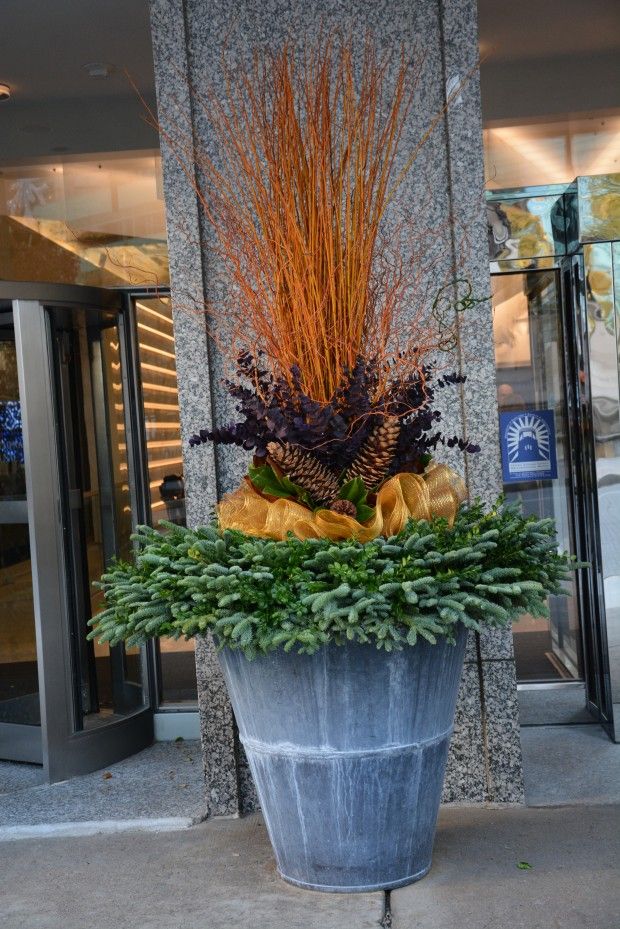
Tips for Preparing Winter Plants for Pots
- Select a frostproof container – Choose a pot with drainage holes in the bottom.
Clay and terracotta pots are prone to cracking in frost so they should be avoided in most cases as outdoor pots during the winter.
Some good options for winter pots include fiberglass, wood, treated terra cotta, and plastic pots as they’ll offer extra protection for your plant.
You can even try out some window boxes.
Concrete and cement are very reliable in winter months. Here are 3 really unique DIY concrete planters you make– a cement balloon planter, vibrantly dyed concrete planter and this modern white concrete planter.
- Choose a good potting soil – Use a mix that is specifically made for containers as it provides essential drainage.
- Stop feeding plants in the fall – Stop feeding your plants about 6-8 weeks before your first frost date.
This prevents new growth which is often tender and won’t survive the winter.
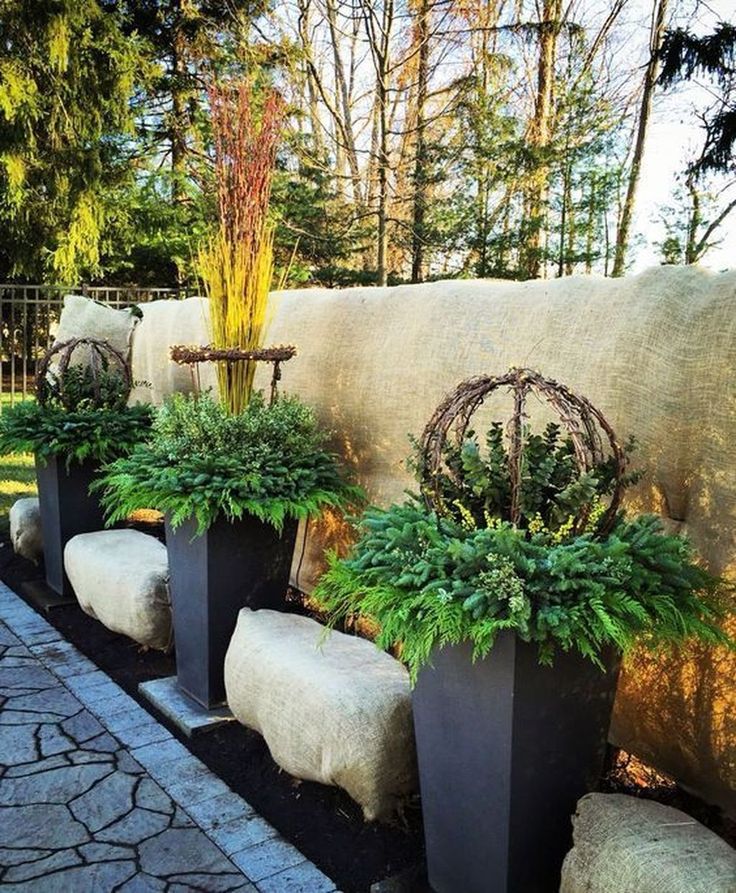 You can start feeding them again next spring.
You can start feeding them again next spring.
- Water – Water plants as needed until the soil in the container is frozen. Do not continue watering frozen pots because the plants won’t be able to absorb water.
Can flower pots stay outside in winter?
As a general rule of thumb, yes. There are many hardy perennial plants and shrubs that are hardy plants for pots for outdoors and the winter weather.
However, plants or shrubs for containers are a bit different than plants in the ground. They are a bit more reliant on you for their care.
If your plant is hardy to two zones colder than the area that you are located, it is likely a good candidate for surviving the winter in a container.
Are there any flowers that bloom in the winter?
You absolutely don’t have to wait for spring to enjoy flowering plants. There are many hardy flowering plants such as:
- Cyclamen
- Snowdrops
- Winter pansies
- Hellebores
- Hardy clematis
What evergreens grow well in pots?
Plants with evergreen foliage make great plants for winter containers.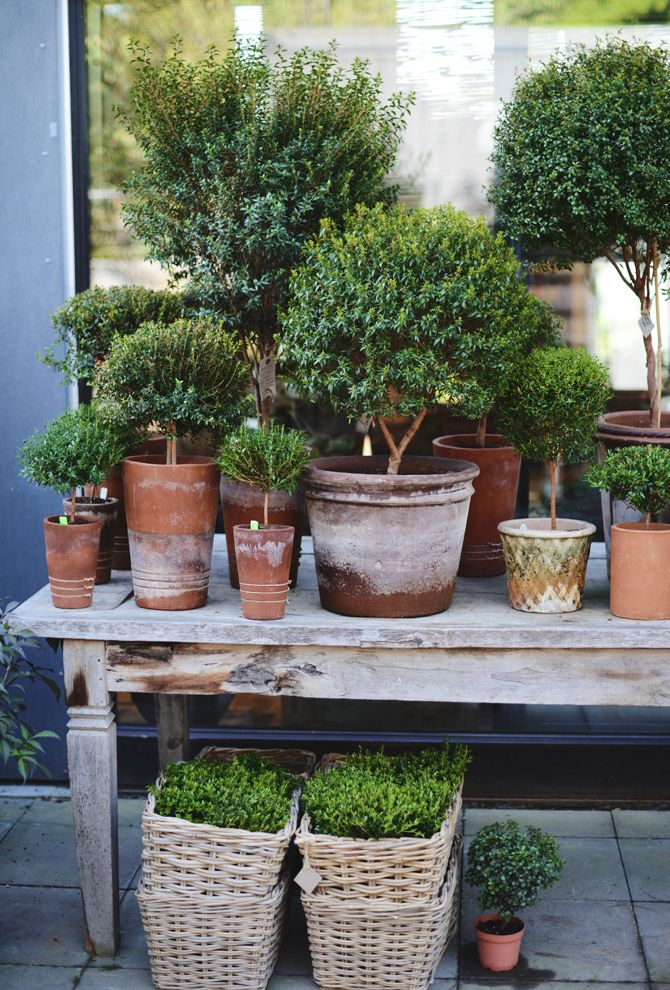
- Japanese Yew
- Potted Blue Spruce
- Boxwood Hedge
- Cypress Topiary
And when spring comes, it will be time to bring those less hardy plants back outside.
That’s what I’ll be doing to decorate the concrete paver patio we recently built. Come take a look!
Don’t forget to Pin it for later!
Best winter plants for pots: 17 bright ideas
(Image credit: The Joy Of Plants)
Gardening Etc Newsletter
The Home Of Outdoor Living
Thank you for signing up to . You will receive a verification email shortly.
There was a problem. Please refresh the page and try again.
By submitting your information you agree to the Terms & Conditions and Privacy Policy and are aged 16 or over.Bright summer blooms inevitably fade as the seasons shift. But, the best winter plants for pots will keep the spirits lifted and the garden looking beautiful, despite colder temperatures and darker evenings.
There are plenty of stunning winter garden ideas that will bring a smile to your face on frosty days. But one of the best ways to brighten up an outdoor space is to plant some gorgeous containers. With flower beds and borders looking a little bare over the coldest season, using pots is a great way to ensure there is still plenty of interest in your yard during the months ahead. Of course, many winter-flowering plants will provide vital nectar for foraging wildlife, too – even more reason for introducing them to your plot.
To give you lots of inspiration, we've rounded up our favorite winter plants you can use in your containers for a stunning display.
Wonderful winter plants for pots to try in your yard
Want to ensure your container gardening ideas are packed with color, scent and interest throughout the colder weather? Our edit of winter plants for pots is the perfect place to start.
1. Wintergreen
Gaultheria procumbens is fabulously festive
(Image credit: Natalia Greeske/Alamy Stock Photo)
Wintergreen (or Gaultheria procumbens) planted in pots makes a cheery addition to outdoor Christmas decor with its vibrant red berries.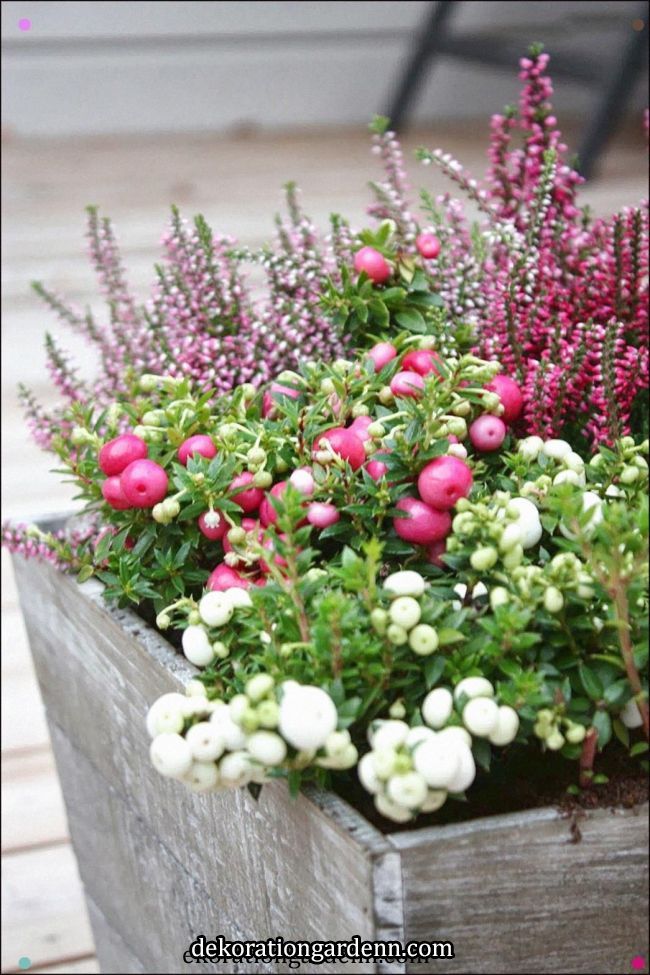 Alternatively, try Gaultheria 'Pearls' which has white berries with a pink flush. Both will thrive in full to part shade.
Alternatively, try Gaultheria 'Pearls' which has white berries with a pink flush. Both will thrive in full to part shade.
Replant these dwarf evergreens in a larger container or into your borders as a ground-cover plant when it's time to give your winter pots a refresh. Be sure to always wear gloves when handling these plants, however, as they are toxic.
- Buy gaultheria in the US: view at Burpee
- Buy gaultheria in the UK: view at Crocus
2. Primulas
'Zebra Blue' has a striking appearance
(Image credit: Petra Cleuskens/Alamy Stock Photo)
Primulas are a classic winter bedding plant, bringing a big boost of bold color to a display. Some are hardier than others, one of our favorites being 'Zebra Blue' which has striped flowers and yellow centers. It blooms in late winter through to late spring and thrives in partial shade. Take a cue from this setup and push structural twigs into the soil for extra height and drama.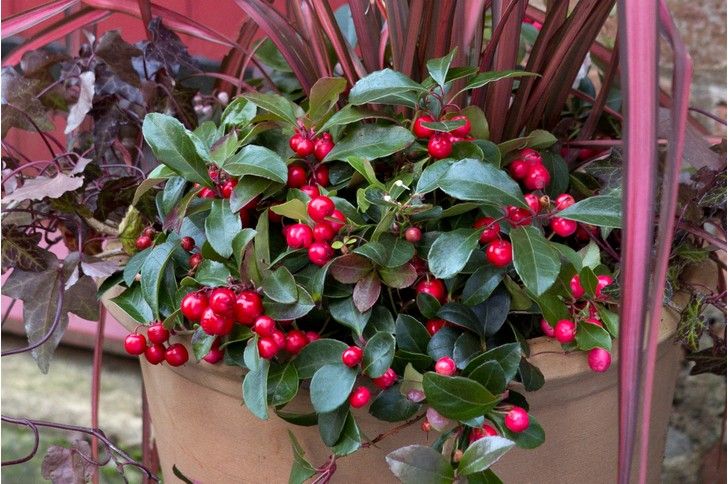
As perennials, keep these beauties going once the season ends by planting them into your borders. As they grow, they will form large clumps which can be divided to improve vigor (and to get 'new' free plants).
Summer or autumn is the best time to do so: 'Simply lift a plant and, using two hand forks inserted close together and back-to-back, divide the clump into chunky, well-rooted portions,' says John Negus, a gardening expert from Amateur Gardening. 'Replant them in a shady spot for summer and, in autumn, set them where they are to flower in spring.'
Polyanthus – a type of primula which produces flowers in umbels – is also one of our favorite winter plants for pots. Sue Sanderson, writing for Thompson & Morgan , recommends ‘Firecracker’ for a fragrant display. Deadhead the flowers often to encourage prolific blooming.
- Buy primulas in the UK: view at Thompson & Morgan
3. Winter irises
The 'Harmony' winter iris offers an eye-catching shot of blue
(Image credit: iBulb)
With their elegant structure and jewel-like tones, winter irises will brighten any patio or doorstep.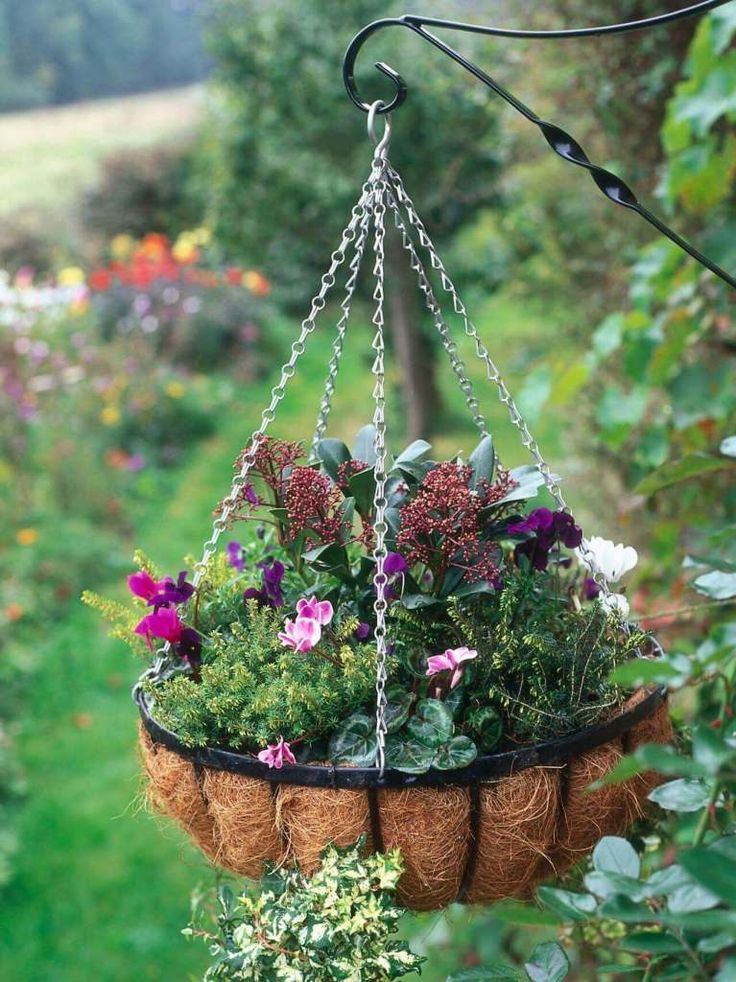 The team at Amateur Gardening suggests 'Harmony' – a stunning bloom with rich purple-blue flowers and a golden band on the fall, which flowers in mid-winter.
The team at Amateur Gardening suggests 'Harmony' – a stunning bloom with rich purple-blue flowers and a golden band on the fall, which flowers in mid-winter.
For something a little different, opt for the ice-white 'Frozen Planet' when planting your winter container, which has pale-blue-tipped petals and will bloom all the way from early winter to spring. 'Pauline' is another beautiful choice, offering a sophisticated shade of plum.
Plant the bulbs in fall in well-drained soil, and for best results, position the containers in full sun. Each plant will grow to around 6in (15cm), depending on the variety.
- Buy winter irises in the US: view at Burpee
- Buy winter irises in the UK: view at Thompson & Morgan
4. Winter aconites
Winter aconites may be small but they're a surefire way to brighten up a space
(Image credit: Natalia Greeske/Alamy Stock Photo)
A wonderful winter garden plant, the sun-yellow flowers of aconites bring reliable cheer. 'After flowering, plant them out in humus-rich moisture-retentive soil in semi-shade, where they will naturalize,' suggests the Amateur Gardening team.
'After flowering, plant them out in humus-rich moisture-retentive soil in semi-shade, where they will naturalize,' suggests the Amateur Gardening team.
They don't grow too tall – only around 4in (10cm). Try planting up a cluster of smaller pots for an instant uplift, or dot the bulbs around the perimeter of a larger container.
Pollinators adore these buttercup-like blooms, so they're perfect if you're looking for winter wildlife garden ideas.
- Buy winter aconites in the US: view at Nature Hills
- Buy winter aconites in the UK: view at Crocus
5. Early crocuses
An array of pots filled with 'Whitewell Purple' crocuses
(Image credit: iBulb)
In shades of yellow, lilac, deep purple and frosty white, early crocuses are perfect for adding to winter planters.
Try 'Pickwick', a larger variety with white goblet flowers and purple veining, which will bloom in late winter in milder regions.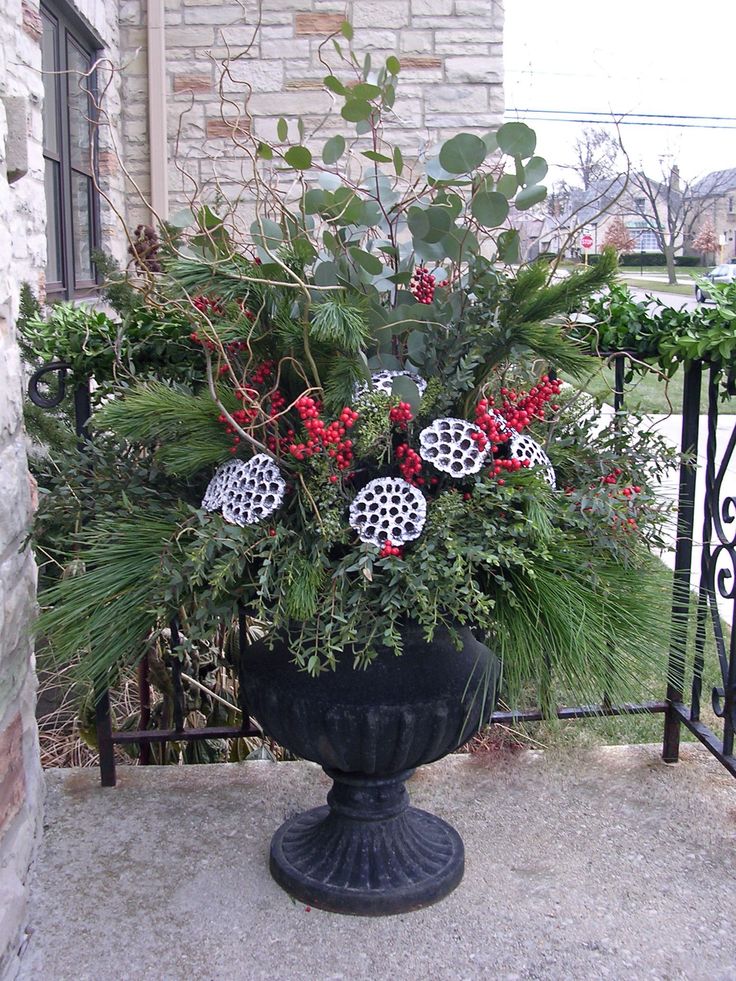 RHS-award-winning 'Blue Pearl' is another favorite with its silvery-lilac petals and deep yellow throats, or try 'Snow Bunting' for white, star-shaped blooms with sunshine-yellow centers. If you love a deeper purple hue, then opt for 'Whitewell Purple', as shown above.
RHS-award-winning 'Blue Pearl' is another favorite with its silvery-lilac petals and deep yellow throats, or try 'Snow Bunting' for white, star-shaped blooms with sunshine-yellow centers. If you love a deeper purple hue, then opt for 'Whitewell Purple', as shown above.
Plant crocus bulbs in well-drained containers positioned in the sun (they won't flower in shade). After flowering, plant them out in a sunny patch of a border or lawn, where they will form clumps over time.
- Buy winter crocuses in the US: view at Burpee
- Buy winter crocuses in the UK: view at Crocus
6. Heucheras
Viola ‘Rose Blotch’ and heuchera ‘Sugar Frosting' make a festive duo
(Image credit: Anne Gilbert/Alamy Stock Photo)
Coral bells, otherwise known as heucheras, have pretty flower spikes in summer. However, the frilly, semi-evergreen, vibrant foliage makes them a good plant for winter color, too, especially in regions where temperatures don't drop too low.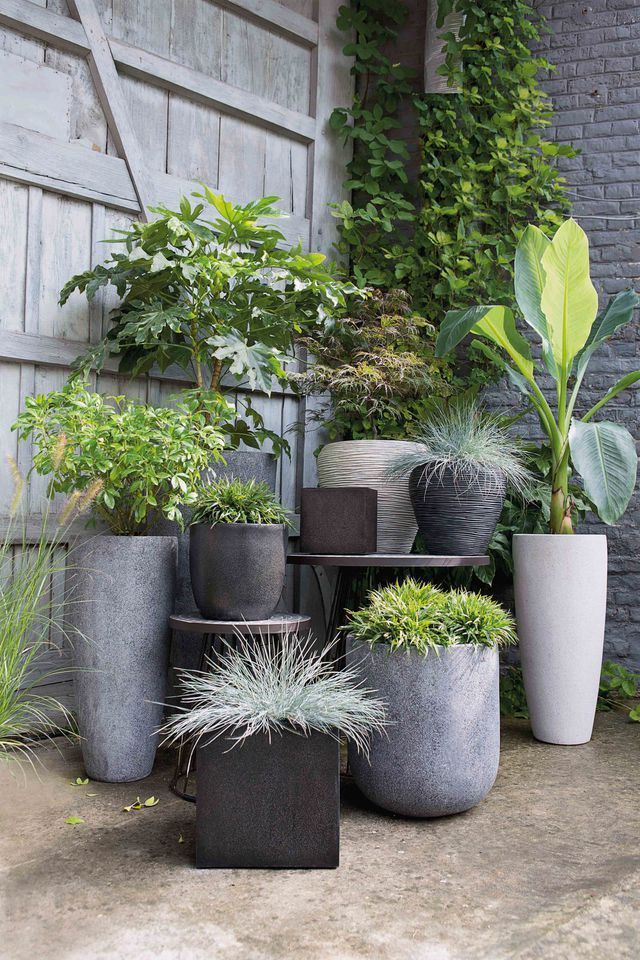
Amateur Gardening suggests 'Marmalade' as a variety to try, with its caramel and pink leaves to warm the winter scene. To set a moody, dramatic tone, opt for 'Black Pearl', whilst 'Sugar Frosting' as shown above looks gorgeously festive against ruby-red viola 'Rose Blotch'.
Plant them in moist, well-drained pots in sun or semi-shade.
- Buy heuchera in the US: view at Nature Hills
- Buy heuchera in the UK: view at Crocus
7. Pansies and violas
Hardy pansies and violas are a classic choice for winter pots
(Image credit: The Joy Of Plants)
Create a container of pansies and you are guaranteed a cheering display all through autumn, winter and into early spring. These bedding plants are one of the best plants for beginners if you follow a few simple rules. Choose plants labeled as 'winter-flowering' to guarantee they will thrive in colder weather.
Plant them out at the start of autumn so they form buds before the frosts arrive. Plant in multi-purpose compost with a handful of grit to aid drainage. In dry spells, or if there is an Indian summer, make sure the compost is moist to touch – plants can still dry out and die in the colder months.
Plant in multi-purpose compost with a handful of grit to aid drainage. In dry spells, or if there is an Indian summer, make sure the compost is moist to touch – plants can still dry out and die in the colder months.
Pack the container with plants for a full display. Deadheading flowers regularly will encourage repeat blooming. For extra impact, opt for one color, rather than a mix of shades – try 'Swiss Giant Orange' for a blaze of gold, or 'Coolwave Raspberry' for a cushion of velvety plum.
- Buy pansies in the US: view at Burpee
- Buy pansies in the UK: view at Thompson & Morgan
8. Heather
Heather is fantastic for bees and looks gorgeous too
(Image credit: Olga Korica/Alamy Stock Photo)
Whether it is a shade of white or dark pink, winter heather brings delicate beauty to your displays.
Heathers only thrive in acid soil, so buy a bag of ericaceous compost. Add a 1–2in (2.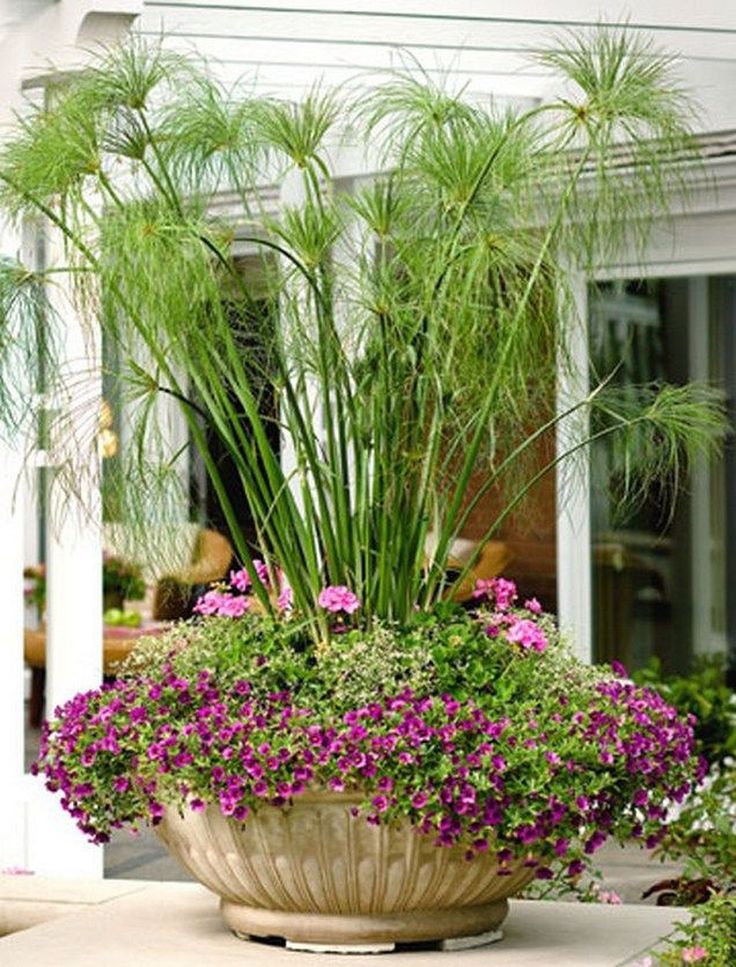 5–5cm) layer of grit at the base of the container first, as they do not like to have soggy roots. Grow them in a sunny spot, or partial shade.
5–5cm) layer of grit at the base of the container first, as they do not like to have soggy roots. Grow them in a sunny spot, or partial shade.
Good choices are E. carnea 'Springwood White', which has trailing stems, and E. carnea 'Springwood Pink' for a bright pop of color.
- Buy heather in the US: view at Nature Hills
- Buy heather in the UK: view at Crocus
9. Foliage plants
This stunning container includes the textural calocephalus to the left, as well as trailing ivy, yellow primula, skimmia, and the jolly orange berries of Solanum pseudocapsicum
(Image credit: mike jarman/Alamy Stock Photo)
Winter containers don't have to feature flowers: there is a fantastic choice of foliage plants available from garden centers or via mail order. Opt for interestingly-shaped, frosted foliage plants such as calocephalus, which has been added to this planter above.
You could also go for the downy leaves of dusty miller (Senecio cineraria) or try the frivolous, frilly leaves of ornamental kale such as 'Northern Lights', which intensifies in color as temperatures plummet.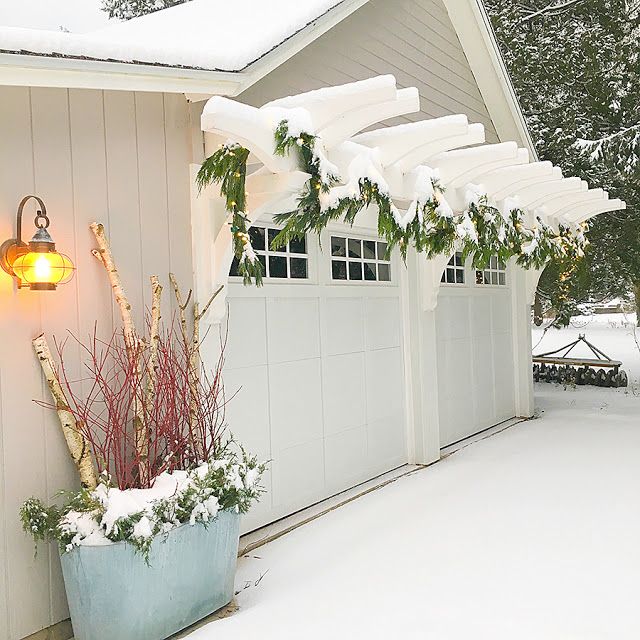
A mix of foliage plants in similar tones looks stunning in the same pot. Soften the edges with an easy-to-grow evergreen trailing ivy such as 'White Wonder'.
- Buy ornamental kale in the US: view at Burpee
- Buy ornamental cabbage in the UK: view at Thompson & Morgan
10. Hellebores
Hellebores work well in modern and cottage-style gardens alike
(Image credit: The Joy Of Plants)
The Christmas rose, or hellebore, adds a touch of romanticism in the bleaker months. They come in a subtle rainbow of colors, from pure white and dusty pink to apricot and rich purple and they can cope with cold conditions, including frost and snow.
Hellebores are mainly evergreen, flowering in mid-winter and continuing to early spring. They can be combined with other plants in the same pot, but a simple container of one color will create maximum impact.
Plant them in a multi-purpose compost in a container, deep enough to fit with the top of the existing compost level.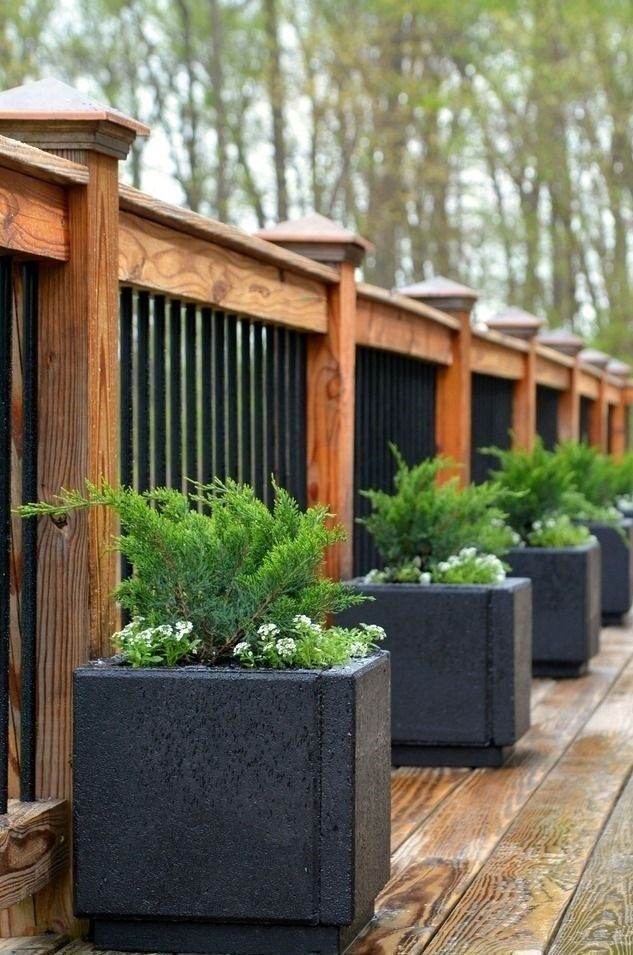 Water well and place in a shady spot.
Water well and place in a shady spot.
- Buy hellebores in the US: view at Burpee
- Buy hellebores in the UK: view at Crocus
11. Scented plants
Sweet box, or Sarcococca confusa, is a brilliant choice for winter pots, available from Crocus
(Image credit: Crocus)
Although we associate scented plants with warm summer days, there are some cold-weather heroes which are perfect for placing by the porch for a blast of winter fragrance.
Sweet box, or Sarcococca confusa, is a brilliant option for the best winter plants for pots. It has a profusion of tiny, spidery, white flowers on glossy evergreen leaves in the winter, which turn into black berries over summer. It's an easy-care plant, with no pruning needed. Just remove any dead sprigs in late spring. For best results, plant in John Innes No.3 compost, and make sure that the soil is kept moist.
For a beautiful citrus scent in a pot, try winter-flowering honeysuckle (Lonicera fragrantissima) which has creamy-colored flowers on semi-bare branches.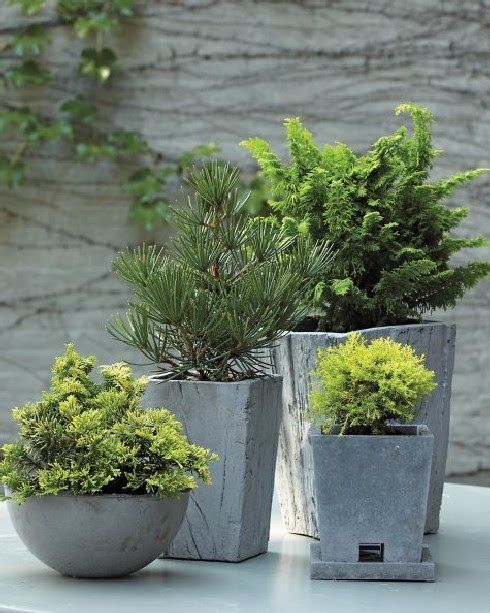 Plant in a large container for the best results.
Plant in a large container for the best results.
- Buy Sarcococca confusa in the US: view at Nature Hills
- Buy Sarcococca confusa in the UK: view at Crocus
12. Japanese skimmia
Red-berried skimmia will add bold color to your container display
(Image credit: The Joy of Plants)
Japanese skimmia has domes of neat evergreen foliage, and the female plants – such as 'Kew Green' or 'Rubella' – are one of the best plants with winter berries. Just ensure you pair them with a male variety, otherwise, you might not get any berries at all.
The shrubs prefer partial shade, and they will cheer up a dark spot.
- Buy skimmia in the US: view at Nature Hills
- Buy skimmia in the UK: view at Thompson & Morgan
13. Camellia
Bring the beautiful blooms of camellia to your garden
(Image credit: The Joy Of Plants)
It's worth learning how to grow camellias for the spectacle of showy flowers.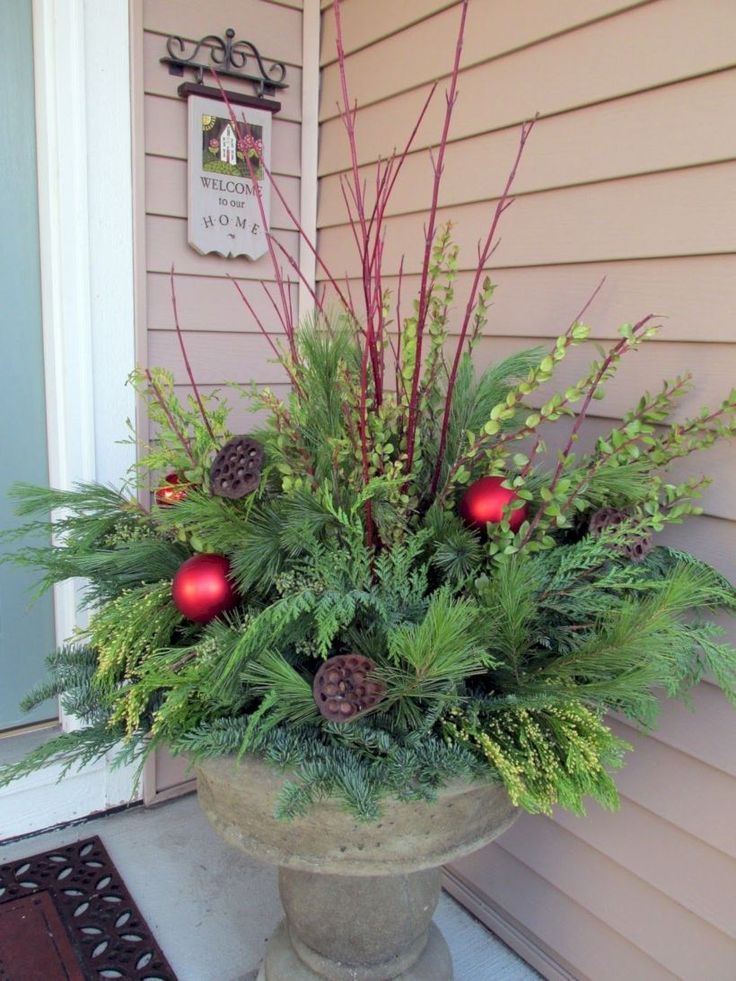 Camellias come in shades of pink, red and white, and their blooms contrast with their evergreen foliage.
Camellias come in shades of pink, red and white, and their blooms contrast with their evergreen foliage.
They're ideal for growing in pots to add some interest to your winter patio. But, they do need to be planted in well-drained ericaceous (acid) soil, and if possible, they should be watered with rainwater from a water butt.
Put them in a sheltered spot near the house, and protect early buds from frost with horticultural fleece. Prune after they have flowered, and keep them well-watered through spring and summer, as this is when the buds are forming. It's definitely worth the effort, as they will reward you with a stunning display in late winter and early spring.
- Buy camellias in the US: view at Nature Hills
- Buy camellias in the UK: view at Crocus
14. Festuca glauca
Brilliant in a container, blue fescue is a mystical blue grass with very fine foliage
(Image credit: BIOSPHOTO/Alamy Stock Photo)
Ornamental grasses fit beautifully into a modern garden, but some of them are perennials which die back in the winter.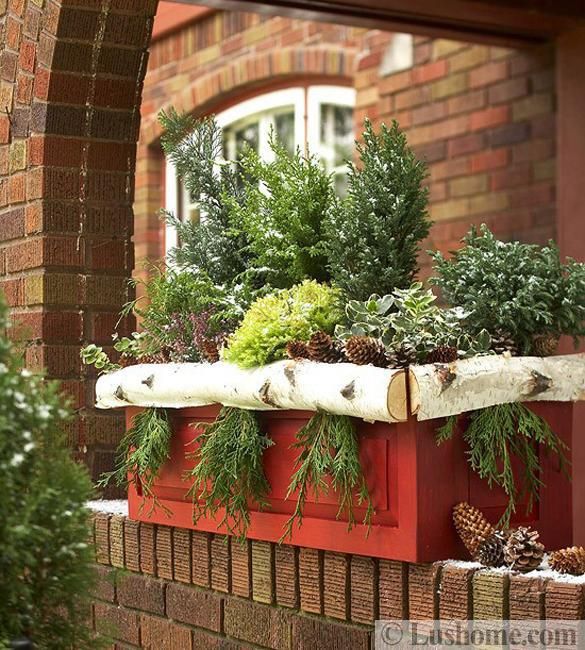 Add a few pots of tasteful blue fescue (Festuca glauca), however, and you get a lot more bang for your buck with a year-round display of texture and a soft blue-green color.
Add a few pots of tasteful blue fescue (Festuca glauca), however, and you get a lot more bang for your buck with a year-round display of texture and a soft blue-green color.
The spiky hummocks of foliage look particularly good in galvanized zinc containers. They need moist, well-drained soil, so add a handful of grit to the compost when planting.
The grasses might benefit from being divided every three years to stop them from looking shabby. With a sparkling coat of frost, they will bring pleasure to the coldest days.
- Buy Festuca glauca in the US: view at Nature Hills
- Buy Festuca glauca in the UK: view at Thompson & Morgan
15. Cyclamen
We love this colorful combo of pink cyclamen and turquoise pots
(Image credit: The Joy of Plants)
The flag-like flowers of cyclamen offer tons of beauty and are perfect plants for winter hanging baskets as well as pots.
The ones on sale in supermarkets tend to be tender, indoor cyclamen.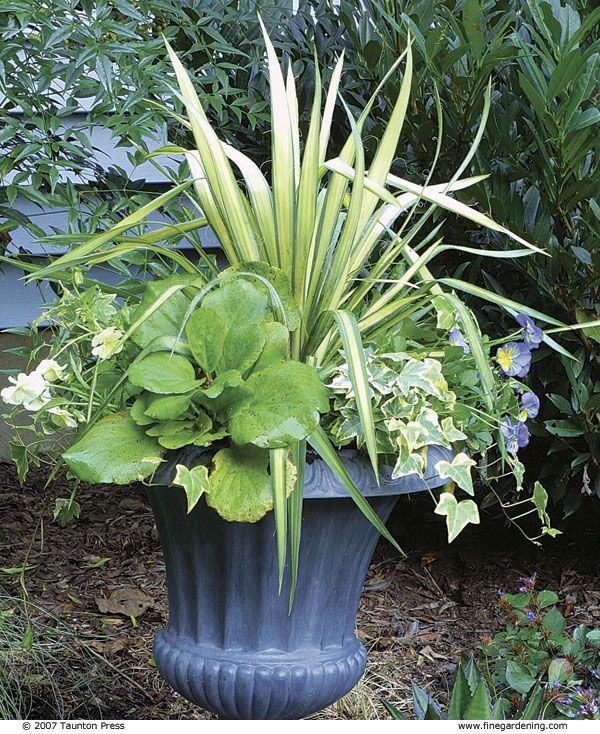 So, make sure you choose a hardy variety called Cyclamen coum or Cyclamen hederifolium if you're after the best plants for winter pots. Plant them at the same depth as the pots you buy them in and avoid letting the containers become waterlogged, as this will damage the roots.
So, make sure you choose a hardy variety called Cyclamen coum or Cyclamen hederifolium if you're after the best plants for winter pots. Plant them at the same depth as the pots you buy them in and avoid letting the containers become waterlogged, as this will damage the roots.
They can be bought as bulbs, but for a quick solution, ready-grown plants are inexpensive and create an instant uplift.
- Buy cyclamen in the UK: view at Crocus
16. Snowdrops
Snowdrops are a true winter favorite
(Image credit: iBulb)
They're among the first spring bulbs to nose through the ground in winter, and a pot or two of snowdrops delivers a welcome boost.
Snowdrop bulbs can be planted in the autumn, or they may be grown 'in the green' (with their leaves still attached) in spring for flowering the following winter. They are happiest when growing in the ground in a shady garden border or raised bed – those grown in containers will need repotting every year.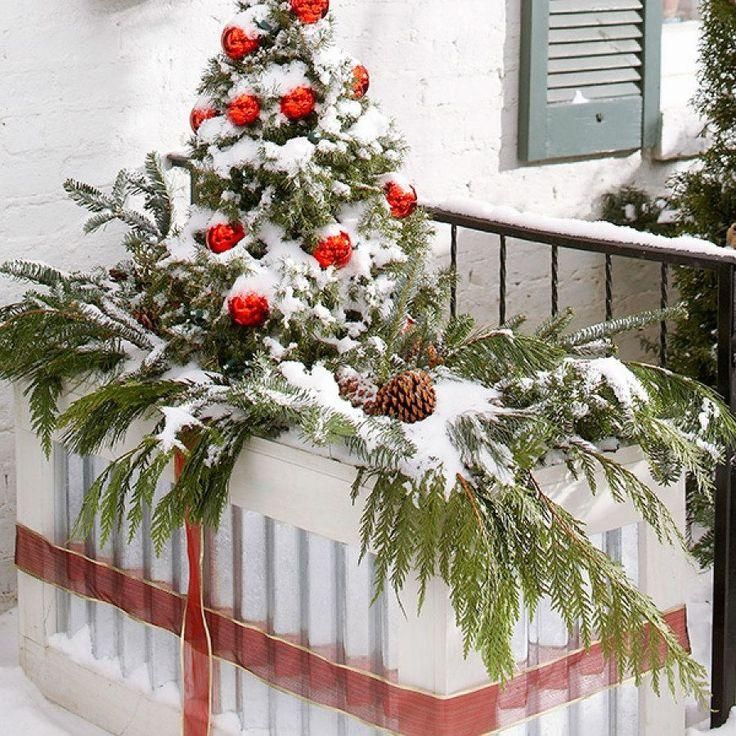
Don't forget about the greater snowdrop too (Galanthus elwesii) – it has large, honey-scented white flowers above glaucous leaves.
- Buy snowdrops in the US: view at Burpee
- Buy snowdrops in the UK: view at Amazon
17. Forced bulbs for indoors
White muscari have an understated elegance
(Image credit: iBulb)
Winter containers aren't just for outdoors. Forcing bulbs is a lovely way to brighten up your interior and enjoy spring flowers early. There are all kinds you can try, from muscari (as seen above) to narcissus and sweetly-scented hyacinths.
Hang them up, decorate a window sill, or position them on the center of your dining table – they are bound to bring joy to any onlooker.
- Buy spring bulbs in the US: view at Burpee
- Buy spring bulbs in the UK: view at Amazon
What plants are good for winter pots in shade?
Even a garden that doesn't get much sun can be brightened with a container, providing you choose shade-loving plants.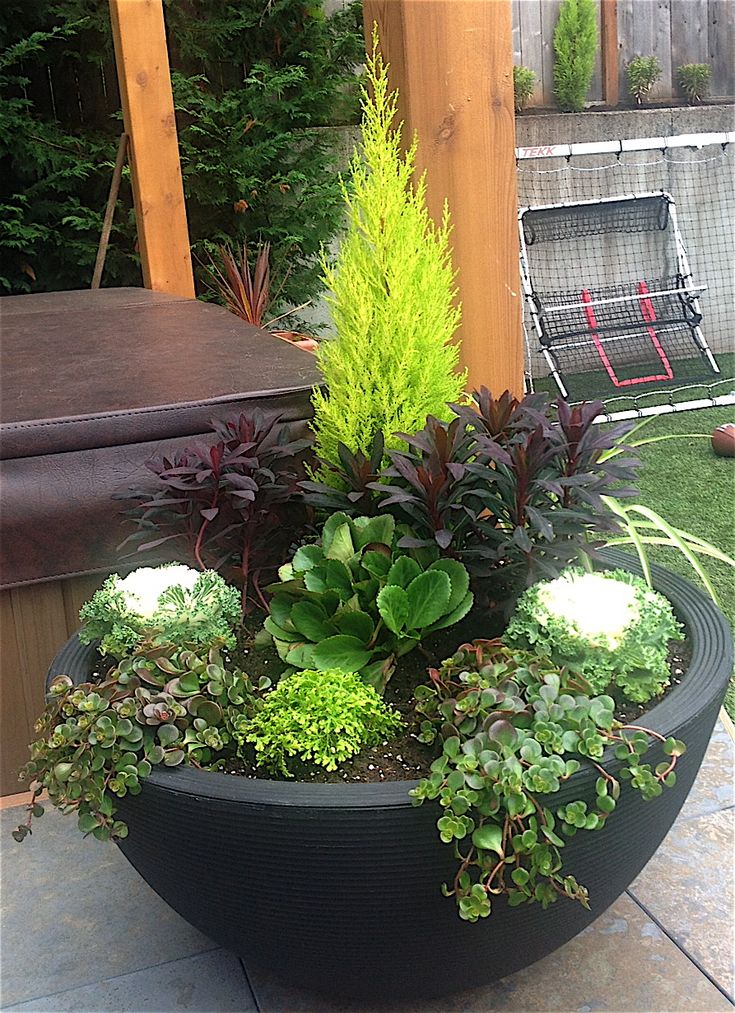 Try these three winter varieties:
Try these three winter varieties:
- Skimmia japonica 'Obsession': This evergreen shrub, growing to 31.5in (80cm), has red berries in fall and winter and scented spring blooms. It grows best in moist, well-drained pots of regular or ericaceous compost in sheltered shade or semi-shade.
- Mahonia x media ‘Charity’: An evergreen shrub, 13ft (4m) in height, this plant has architectural foliage and yellow flowers that exude a beautiful scent in winter. After flowering, plant it out in humus-rich soil in shade or semi-shade.
- Hedera helix ‘Buttercup’: This slow-growing trailing ivy has lime-green and lemon-yellow leaves when positioned in a shady spot, or bolder yellow leaves in sun. Avoid overcrowding, and plant in well-drained soil.
Skimmias thrive in shade
(Image credit: The Joy of Plants)
How often do you need to water winter pots?
True, summer is peak time for watering plants.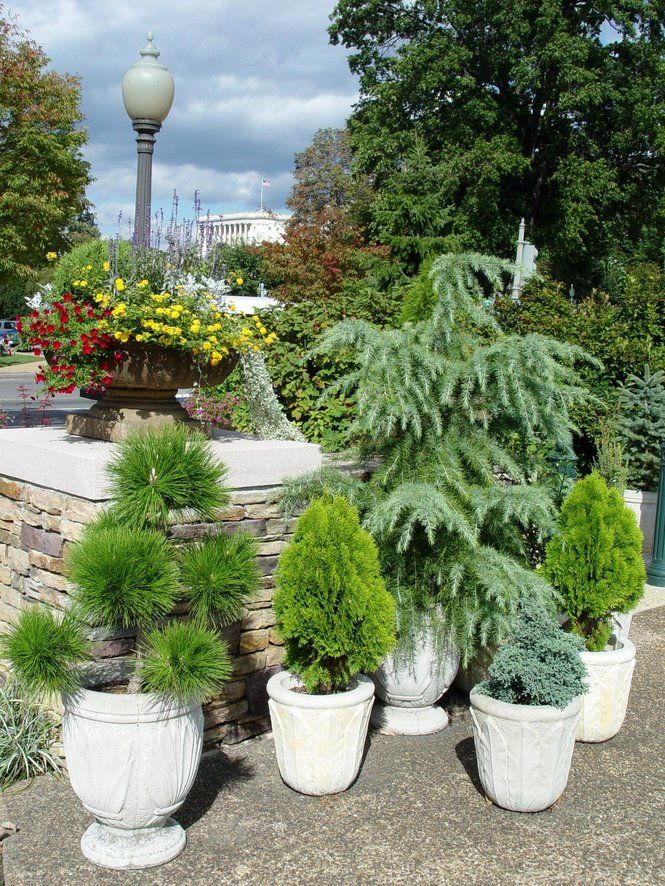 But your containers will still need some attention with the watering can from time to time in winter, especially after sunny or windy weather.
But your containers will still need some attention with the watering can from time to time in winter, especially after sunny or windy weather.
The RHS explains how conifers and other evergreens should be checked at least weekly and watered if necessary, especially if they are under cover. However, avoid watering if frost is forecasted.
It's important to ensure that your containers have good drainage. Allowing plants to sit in cold, waterlogged soil will do them no good at all.
These pretty garden planters include viola 'Antique Shades', 'Sorbet Blueberry Cream' and 'Rose Blotch'
(Image credit: Anne Gilbert/Alamy Stock Photo)
An experienced freelance journalist, editor and columnist writing for national magazines and websites, Fiona now specialises in gardens. She enjoys finding and writing about all kinds, from the tiniest town plots to impressively designed ones in grand country houses.
With contributions from
- Holly CrossleySenior Content Editor
10 plants for year-round containers!
When the air turns cool in autumn, gardeners often discard, propagate or find a home for their outdoor potted plants.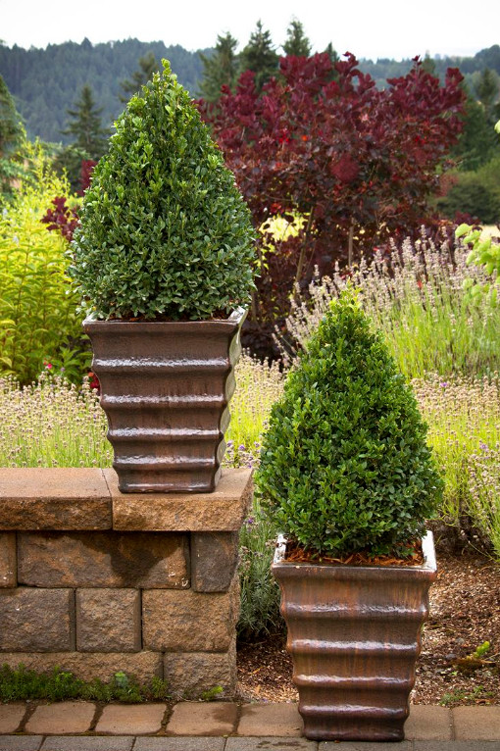 Too bad, because most of it is a waste of effort and plants. Many perennials and shrubs can live in a container for several years. By taking advantage of this feature, you can reduce the amount of time and money you spend on your plants. Your containers can be of year-round interest, depending on the plants you choose, and you can bring consistency to your designs.
Too bad, because most of it is a waste of effort and plants. Many perennials and shrubs can live in a container for several years. By taking advantage of this feature, you can reduce the amount of time and money you spend on your plants. Your containers can be of year-round interest, depending on the plants you choose, and you can bring consistency to your designs.
For a plant, life in a container is very different from life in the open field. Containers can provide excellent drainage, however plants are dependent on water and nutrients. Shrubs and large perennials often remain smaller in a pot, although this depends on the plant, climate, and container. In addition, open ground does not insulate the plant's roots from winter temperatures.
The general rule for container plants to survive the winter is that the plant should be cold hardy and have a hardiness zone of 3 or 4.
Tips for winterizing plants in containers
Choose a frost-resistant container.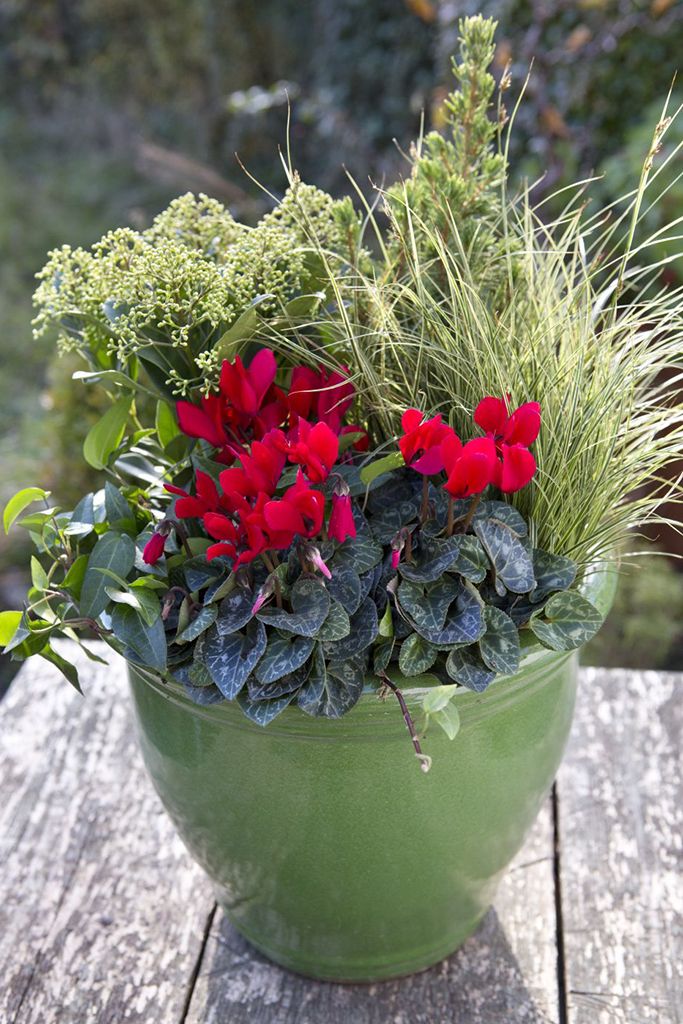 Choose a pot with a drain hole at the bottom and made from fiberglass, lead, iron, heavy plastic, or stone. Most terracotta will crack at low temperatures.
Choose a pot with a drain hole at the bottom and made from fiberglass, lead, iron, heavy plastic, or stone. Most terracotta will crack at low temperatures.
Use good potting soil. There are mixtures specifically designed for container use that provide the necessary drainage required by potted plants.
Stop feeding in autumn. If you are using a water soluble fertilizer, stop feeding your plants about six to eight weeks before your first frost date. This will prevent any tender growth that won't survive the winter. Start fertilizing again when the plants resume growth in the spring.
Watering in winter. Water as needed until the soil in the container freezes. Do not water frozen pots because the plants are unable to absorb water.
Repot every few years. While some plants will live longer in a container, repot your plants every three years to be on the safe side.
Container perennials
Through trial and error, we have found many plants that can live in a container year after year.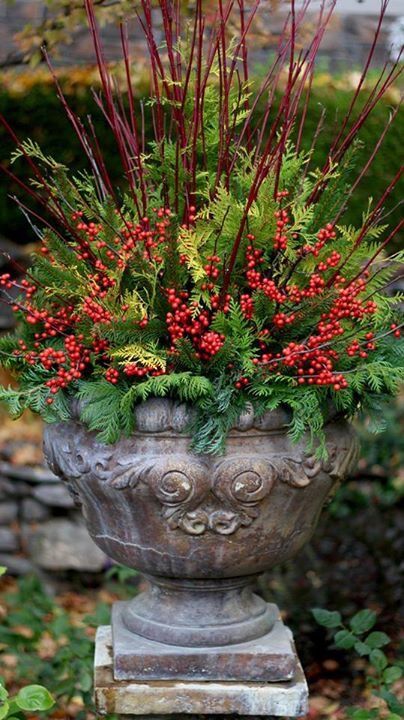
We've selected the top 10 plants that are not only strong enough to survive, but also look great while doing so.
1. Yucca Filamentosa
This yucca pairs with just about anything. Its 4 cm wide sword-like leaves have thin and dark green margins with curly fibers. Having a prickly architectural form, it grows by 30–90 cm wide with equal spacing. This yucca tolerates some shade but thrives in sunny, dry conditions. In summer, creamy-white, fragrant flowers appear from the center of the plant on stems as high as 180 cm. In late winter, the foliage may become a little flat, but in spring it will revive again. Remove old foliage to keep a neat appearance.
2. Boxwood Evergreen
Planting in a container will keep it within limits. And therefore, the box will have a lower height than under normal conditions.
Place the boxwood away from strong winds in a semi-shady area. If possible, rotate the pot periodically to balance the effect of the light on the plant and avoid developing bare sides.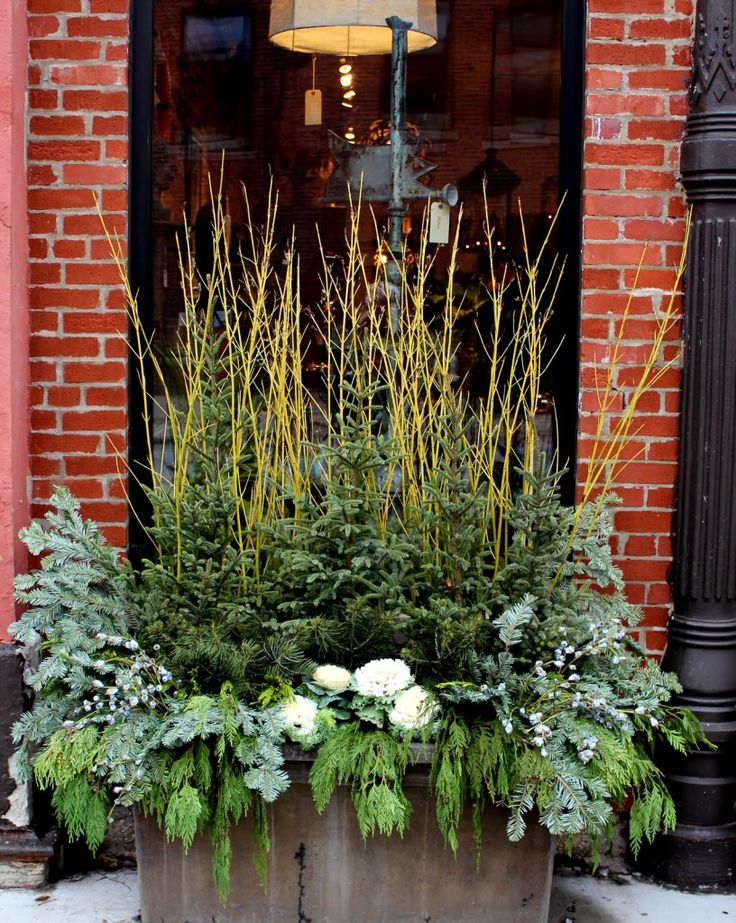
Boxwood is a slow growing shrub that retains a dark green color throughout the winter. The shrub lends itself well to pruning, and you can give it any shape.
3. Coin Loaf
Coin Loaf is a really reliable container performer. This plant, 12 cm high, lays beautifully on the edge of the pot. Its coin-shaped bright green leaves look good with all neighbors. It loves partial shade but loves water so much that it will do well in a water garden. The loosestrife can take full sun, but you must keep the soil moist.
4. Japanese Pieris
This pest resistant shrub (Pieris japonica) is an excellent container candidate. Although its evergreen foliage is of interest at any time of the year, spring growth on Japanese pieris is particularly impressive, ranging in color from glossy red to salmon pink and even creamy white depending on the variety.
In winter the flower buds are showy, usually dark red with some hints of pink. Thin brushes from 9up to 12 cm of urn-shaped white flowers appear in early spring and are lightly scented. Graceful branches of this shrub naturally cover the edges of pots.
Graceful branches of this shrub naturally cover the edges of pots.
Japanese pieris grows in both full sun and full shade areas. Keep it away from harsh winter winds and strong sun.
5. Thuja Smaragd
Thuja Smaragd (Thuja occidentalis Smaragd) provides excellent year-round interest. Even in winter, it retains its rich green color. The vertical, narrow habit of this variety fits the bill for the vertical accent that many containers need.
The shape and texture of its foliage makes it easy to combine with other plants. Plant this thuja in the sun or in the shade.
6. Bergenia
With their green, glossy, oval leaves, bergenia or bergenia are among the most interesting plants. Bergenia is a strong manufacturer that provides a bold element in container design. The leaves are 20 to 40 cm long and 20 to 32 cm wide, and take on a magnificent burgundy color in autumn. Bergenia blooms in early spring on stems 25 to 30 cm long. Pink flowers resemble hyacinths.
The plant looks better in containers than in flower beds, perhaps because of the excellent drainage. Grow it in full sun or light partial shade.
7. Dogwood Elegantissima
Another shrub that does well in a container is the variegated red-branched dogwood (Cornus alba 'Elegantissima'). Its leaves have white edges and grayish green centers, and the bright red stems shine in winter, especially if they have an evergreen background.
The variegated leaves of the bush make a beautiful frame for hydrangeas in the ground on both sides. Dogwood's deepest color appears on young stems, so remove older branches in early spring. Place this shrub in full sun. Or in partial shade.
8. Geichera
Geichera are attractive, low growing perennials that contrast with tall plants in a container. Their lobed foliage can be showy, often veining silver through green or purple leaves. Geichera are especially suitable for containers because they like well-drained soil and recover easily from winter.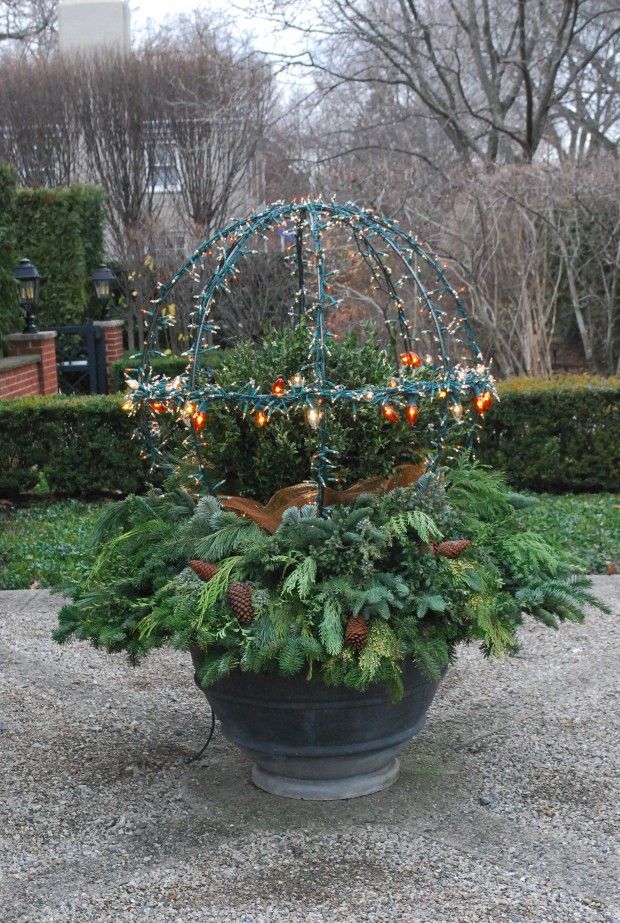
Most geichera grow into mounds 24 to 36 cm in diameter and in the summer throw out flower panicles with white, pink or red flowers. First of all, they can grow in full sun. But they can also be in full shade, depending on the variety.
9. Blue Star Juniper
Has a useful color. The low growing 'Blue Star' juniper (Juniperus squamata Blue Star) has densely spaced steel blue needles 0.5 cm long. This color makes the plant stand out in winter. It reaches 90 cm in height and spreads to 90-120, but it grows slowly.
Blue Star works well in containers because it blends easily with most colors. Its branches elegantly curve around the edge of the pot.
Prefers full sun but will accept partial shade. In addition, this juniper does not like wet conditions.
10. Sedum 'Fuldaglut'
Sedum 'Fuldaglut' (Sedum spurium 'Fuldaglut') is dominated by a bronze-red leaf color that turns red in winter. The delicately serrated leaves are larger than most species and are covered in late summer with pink flowers that last for three weeks. Measuring just 12 cm high and 24 cm wide, this sedum graces the edge of a container. He loves full sun. However, will grow in partial shade.
Measuring just 12 cm high and 24 cm wide, this sedum graces the edge of a container. He loves full sun. However, will grow in partial shade.
Read also What should be done in the flower garden in September?.
Garden plants on the open balcony in winter: mission possible?
EventsIdeasUseful little thingsGarden decorsLandscape designOtherTips
29.01.2018
Landscaping
Russian winter leaves little space for gardeners to express themselves. Of course, during this period, it remains possible to temporarily switch to indoor floriculture, in particular, the creation of plant compositions in flowerpots on city balconies and loggias.
Let's say right away - there are few solutions for the cold season, many difficulties. Even if you manage to choose frost-resistant plants that can grow well in pots in winter, alternating snowfalls and heavy rains threaten to negate the entire decorative effect of landscaping an open balcony.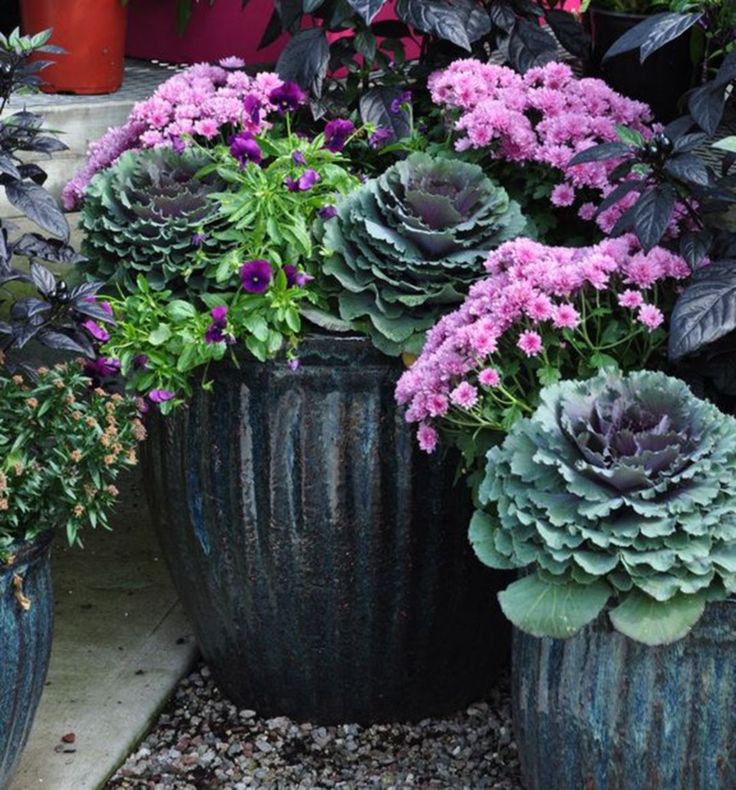
Yet true gardening enthusiasts are up for the challenge! We have selected plants that can decorate an unglazed balcony in winter. So it is quite possible to create a frosty oasis that will not lose its charm even under a layer of snow.
Important! The vast majority of winter frost-resistant plants do not tolerate stagnant water in the ground. Therefore, task number 1 is to choose the right pots for the balcony. It should have thick walls and good water and air permeability characteristics. Additional insulation of the pot inside will not hurt either. Terracotta and ceramic pots and planters are best suited, but glass and metal are best left until warmer times.
Heather
Of course, heat-loving indoor flowers on the balcony will not survive, but some types of plants tolerate winter conditions well, retaining their beauty and decorative effect. For example, heather is an evergreen perennial with a lilac-purple color that contrasts beautifully with white snow. In a garden in winter, heather requires shelter, as it is adversely affected by excessive moisture during thaws. But the atmosphere of the city balcony is quite to his liking - it is enough to transplant a heather bush into a planter and provide a "roof over his head."
In a garden in winter, heather requires shelter, as it is adversely affected by excessive moisture during thaws. But the atmosphere of the city balcony is quite to his liking - it is enough to transplant a heather bush into a planter and provide a "roof over his head."
Ornamental cabbage
Ornamental cabbage is a new favorite of landscape designers and gardeners in Russia. Unpretentiousness, frost resistance and expressive leaves that become brighter with the onset of cold weather make it an excellent solution for decorating a balcony. Ornamental cabbage easily tolerates transplanting into a container, winters well outdoors without additional insulation and is an excellent "companion" for decorative compositions in flowerpots.
Conifers and evergreens
The classics of winter gardening of a balcony in our latitudes are evergreen trees and shrubs. Dwarf spruce, pine, thuja, cedar in large pots will not only improve your view from the window, but will also become the basis for stunning Christmas compositions. Conifers in flowerpots, some snow and a couple of garlands are a traditional recipe for a good mood in winter.
Euonymus
Euonymus is an evergreen shrub or tree, the main decoration of which is bright leaves that turn into various variations of pink, crimson and purple. Pleasing with unusual shades and fruits-boxes, which sometimes persist until the very frost. Many varieties of euonymus feel comfortable at a temperature of -35 0 C - however, only in the garden. When planted in a flower pot, the frost resistance of the plant decreases, although they are still able to withstand a small minus.
Hellebore
A beautiful winter flower that can live in a pot on a balcony up to -10 0 C. Its natural flowering starts in November and ends in spring. Expressive snow-white flowers look spectacular in flowerpots, as well as in bouquets and decorative compositions with dried flowers and moss.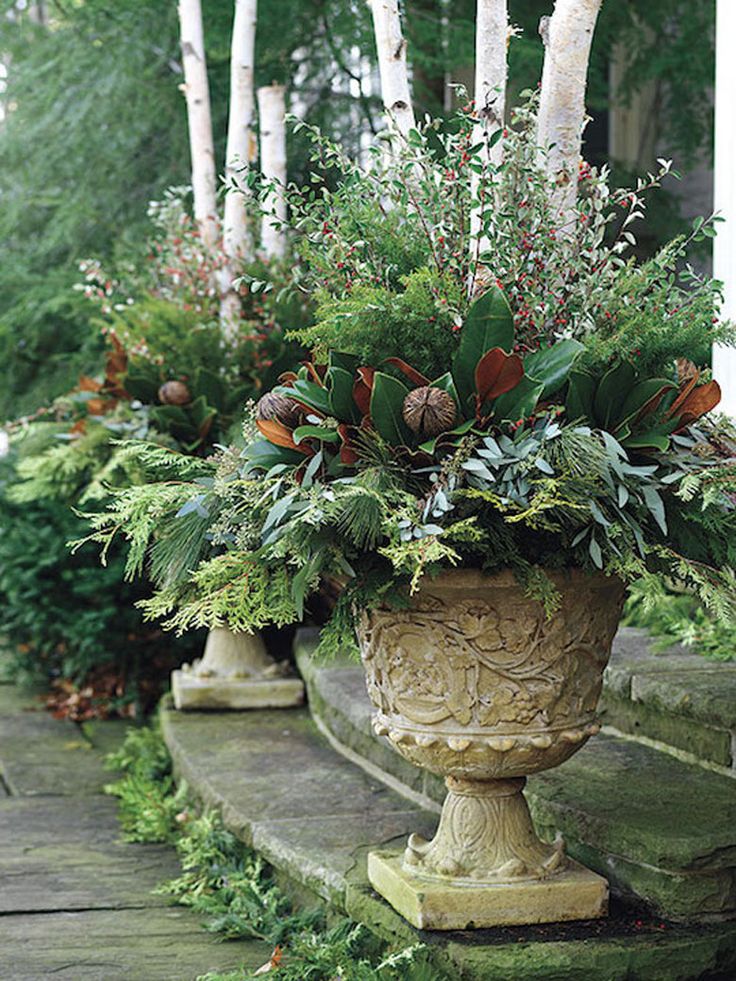 In severe frosts, the plant "hibernates" and looks frozen, but this impression is deceptive - the hellebore simply draws moisture from the buds to prevent them from freezing. To protect the flower from frost and temperature changes, it is recommended to cover the plant with coniferous spruce branches.
In severe frosts, the plant "hibernates" and looks frozen, but this impression is deceptive - the hellebore simply draws moisture from the buds to prevent them from freezing. To protect the flower from frost and temperature changes, it is recommended to cover the plant with coniferous spruce branches.
Outdoor balcony garden in summer
It is not a problem to decorate a balcony with plants in the spring and summer period - many plants grow well on an open balcony in the warm season. Dwarf trees in large pots, flower arrangements on the windowsill, climbing and liana-like plants falling from the brackets for hanging planters - the balcony can be turned into an urban “garden branch” (and we will definitely devote a separate article to this issue!).
If you are lucky enough to be the owner of an openwork balcony with a wrought iron railing (the so-called "French balcony"), you can place hanging flower pots outside.
